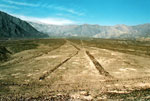About Nazca
Nazca offers like destination a unique place in the world, full of mystery and mysticism, wonderful lines of immense figures and lines, of spectacular perfection, works of a very old Peruvian civilization, the Lines of Nazca.
Just two hours from Ica, 50 square kilometers of desert floor were covered centuries ago by vast drawings, figures of mammals, insects and deities. The Nazca Lines, discovered in 1927, are the most extraordinary legacy left by a culture that flourished in 300 BC. The lines are a series of complex designs, some up to 300 meters long which can only be seen in their true dimension from the sky, from an altitude of at least 1,500 feet. The Nazca culture is not believed to have been capable of manned flight. But the question remains as to how they crafted the drawings, what technology they used and what purpose the lines served.
The Nazca Lines was declared Culture World Heritage Site by UNESCO.
The town of Nazca was founded in 1591 by the Spaniards, on the valley of Nazca, close to towns inhabited by old civilizations that had been dominated by the Inca. The ancestral name was Nanasca.
Nazca (some spelled Nasca), is a gentle town, slowly developing; in which its main economic activity is based on the agriculture, trade and tourism.
Near to Nazca city (50 Km) , more than 600 geoglyphs were discovered in the Palpa area. This recent discovery includes numerous new ruins and geoglyphs and has shed new light on the Nazca investigations.
Tourism to this area is related directly with the Nazca Lines and other archaeological complex as Cahuachi, Estaquería, Chauchilla cemetery, Paredones and Palpa.
Nazca City Overview
-
Location:
Central Coast, 1,929 feet (588 m.) above se level.
-
Distances to Nazca:
-
Population:
25,000 inhabitants
Nazca Guide
Nazca City: Is a little town, located in an oasis valley in the Nazca desert, it has basic and comfortable hotels, restaurants, cybercafes. In the city you will be able to find many ceramic artisans whose style remembers to their ancestor, the Antonini Museum and Planetarium Maria Reiche.
Nazca Lines: Declared "Cultural World Heritage Site" by UNESCO (1994). Located in the arid Peruvian coastal plain, the geoglyphs of Nazca and the pampas of Jumana cover about 450 sq. Km. These lines, which were scratched on the surface of the ground between 500 B.C. and A.D. 500, are among archaeology's greatest enigmas because of their quantity, nature, size and continuity. The geoglyphs depict living creatures, stylized plants and imaginary beings, as well as geometric figures several kilometers long. They are believed to have had ritual astronomical functions. In order to appreciate the lines in all its magnitude, it is only possible from an airplane in flight.
Archaeological Places in Nazca: Archaeological remains of the Nazca culture, it shows the high development reached in hydraulic engineering, complex of underground aqueducts and reservoirs as Cantayoc, also Paredones, Estaquería and Chauchilla cemetery and geoglyphs of Palpa.
Cahuachi: Cahuachi was a ceremonial center, a sacred destination of Nazca pilgrims between 100 and 500 AD. The ceremonies in the place included the construction of temples using thousands of conical or wedge adobe bricks. Each participating community demonstrated their true belonging to their religious community by singing, dancing and banqueting, thus explaining why in Cahuachi there is little garbage, while offerings abound (pan flutes and musical drums, sacrificed llamas and guinea pigs, fine textiles, human burials and pottery representing deities). Main cultural-urban center, built with great urban sense. The ancient Nazca people built their pyramidal temples by terracing the fossil sand dunes. In the lowers parts, smaller architectural mounds, streets and squares give the site a general city aspect. Attached to this town were also discovered (1980) a group of lines traced on the floor in form of trapezes and serpentines that embrace 1 square Km. It is located at 27 Km (16.77 miles) to south of Nazca.
Around Nazca: Interesting places to visit around Nazca city as Pampas Galeras and San Fernando natural protected areas, Sacaco is a rich location of fossil remains, Maria Reiche Site Museum, Cerro Blanco the highest-know sand dune in the world for sandboarding.
Antonini Didactic Museum: Located in Avenida La Cultura 600. Visiting hours: Mon. – Sun. 9:00 A.M. – 7:00 P.M. A collection of archaeological pieces of the different stages of the Nazca culture as well as trophy heads, musical instruments like pan flutes, textiles, mummies, etc. are exhibited in this museum. These discoveries are the result of the excavations done in "Cahuachi", the largest mud maid ceremonial center in the world. The museum also provides the chance to see the Bisambra canal, which shows the magnificent hydraulic engineering work of the Nazcas.
Planetarium Maria Reiche: Venturing into boundaries of the world archae-astronomy, the Nazca Lines show present Maria Reiche's theory, and the connection she found between the Nazca Lines and some astronomical events. She theorized the lines were oriented towards the places on the horizon where different celestial objects appeared and disappeared. After the show, weather permitting in a backyard exploration of the night sky, have a naked-eye view of the constellations and bright stars of the season along with telescope, observation of the moon, planets, and other celestial marvels. Located in Jr. Bolognesi Nº 300 - Hotel Nazca Lines.
If you visit Nazca, you can continue your trip to Cuzco by bus (12 hours) or go directly to Arequipa City (8 hours). These trips are at night and thus you will gain a day if you do not return to Lima (Go to bus services).
We recommend you visit combined Nazca with Paracas, Cuzco or Arequipa.












